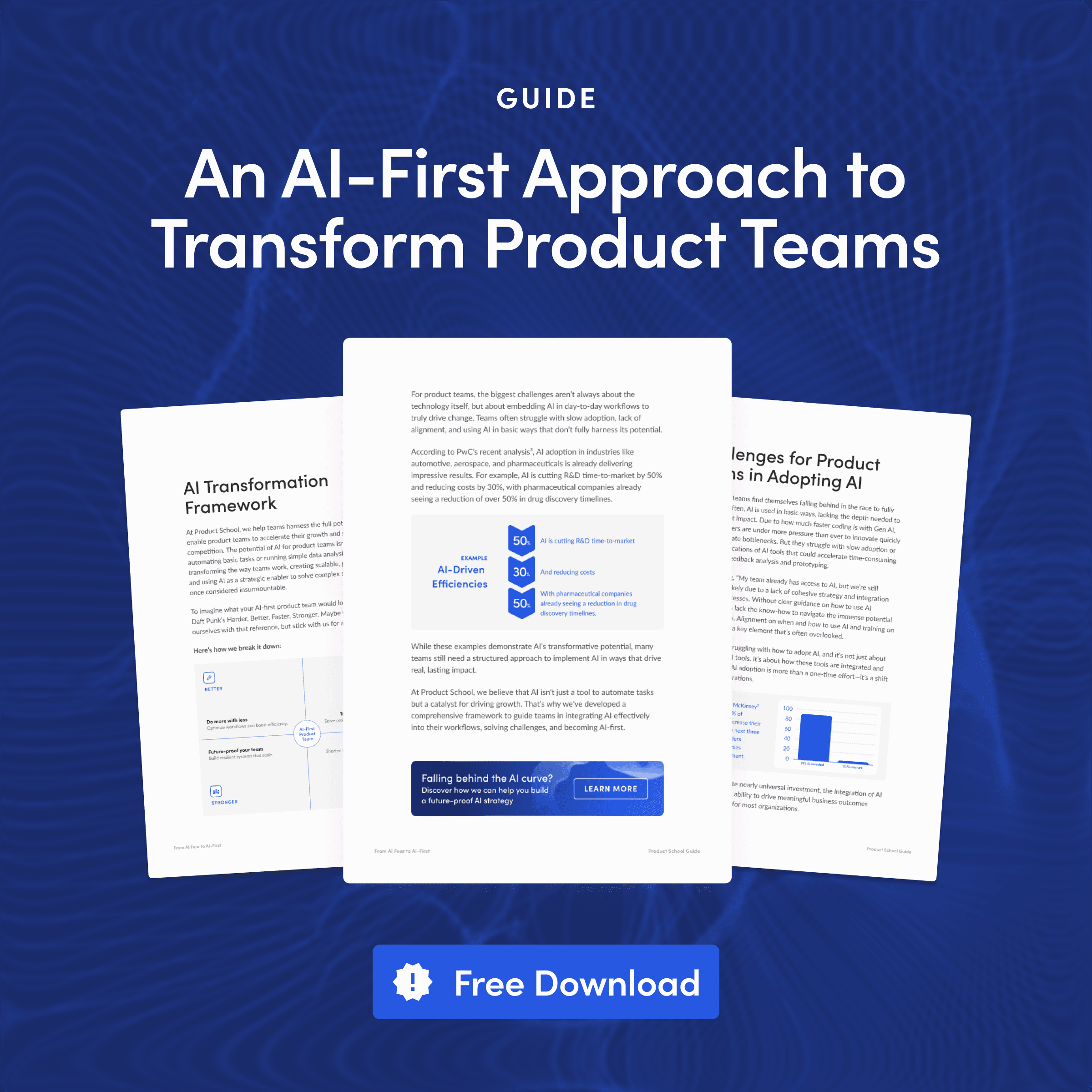Updated: October 20, 2025- 19 min read
Much like chatting about the weather or last night's game, AI is a part of everyday conversation. It’s no longer the domain of the most technical among us. Yet, for many businesses, AI implementation remains a tricky proposition.
Evaluating the true worth of these tools calls for a serious effort — at least it should. It requires decision-makers to juggle the thoughts of immediate benefits and costs of awaiting a promising future. They need to carefully examine the use cases before assuming the state-of-the-art is right for them.
Whatever the approach, many industries are already experiencing significant benefits from implementing this technology. With a healthy dose of skepticism, we've sifted through the noise to bring you real-world AI use cases in business where results are obvious.
Integrate AI into Products and Processes
Get insights on AI product implementation from the CPO at Financial Times, Debbie McMahon
GET THE PLAYBOOK
Join us as we explore examples of how companies are using AI. We’ll cover 15 AI applications across various industries and tips for how your business can follow suit for the following use cases:
1. Personalized Customer Experience
AI tailors interactions and recommendations based on individual customer preferences and behaviors. This is the way companies are driving customer satisfaction and loyalty. It is also one of the most common ways marketing teams and product managers use AI tools.
By leveraging data from various touchpoints such as purchase history, browsing patterns, and social media activity, AI can create a seamless and highly personalized experience for each customer.
How companies use AI:
Sephora implemented AI through its Virtual Artist tool, which allows customers to try makeup virtually and receive personalized beauty advice. This tool has led to increased customer engagement and sales. Customers are more likely to purchase products that are tailored to their preferences. Source: Cut The SaaS.
Amazon uses AI to recommend products to its users based on their browsing history, purchase history, and items in their cart. This has significantly increased cross-selling and upselling opportunities — the very reason Amazon has seen massive growth in sales. Source: AWS Blog.
Netflix employs AI algorithms to recommend shows and movies to its users based on their viewing history and preferences. This personalized experience keeps users glued to the platform and reduces churn. Read more
in our Product Analysis piece.
AI use cases by industry:
Hybrid commerce: Recommends products based on customer preferences and behavior.
E-commerce: Tailors marketing campaigns and suggestions to individual users.
Hospitality: Enhances guest experience through personalized service offerings.
Entertainment: Customizes content recommendations for streaming services.
Healthcare: Provides personalized treatment plans based on patient data.
2. Safety Control
AI enhances safety protocols by monitoring and analyzing data in real time. Using AI in this sense helps identify potential hazards and ensures compliance with safety regulations.
AI-powered safety systems use a combination of sensors, cameras, and data analytics to monitor environments. They are super efficient at detecting anomalies that could pose potential threats. These systems can analyze vast amounts of data from multiple sources simultaneously, allowing for the quick identification of issues that humans may otherwise miss.
Success Stories:
Tesla utilizes AI in its Autopilot system to enhance vehicle safety by continuously monitoring road conditions and driver behavior. This proactive safety measure has resulted in fewer accidents. Tesla's AI system can take control of the vehicle to avoid potential collisions, making driving safer for everyone. Source: Tesla.
Boeing employs AI to detect anomalies in aircraft sensors and analyze data collected from flights. This predictive maintenance approach has led to improved flight safety by identifying potential issues before they cause serious problems. Boeing's integration of AI in its operations ensures that aircraft are consistently operating at optimal safety levels. Source: Forbes.
Nest (Google) has integrated AI into its home safety products. Smoke detectors and intrusion detection are now key parts of the system. The AI algorithms help by differentiating between real emergencies and false alarms. They ensure that appropriate actions are taken only when necessary. This smart home technology not only enhances the safety of people’s homes but also provides peace of mind to homeowners. Source: Lifewire.
Industries:
Automotive: AI-driven safety features in vehicles.
Manufacturing: Monitors machinery and workplace conditions to prevent accidents.
Construction: Real-time hazard detection and safety compliance monitoring.
Aviation: Monitors aircraft systems for safety and performance.
Home Security: Enhances the security of residential properties with smart devices.
3. Workforce Optimization
AI helps businesses make managing work schedules easier. It can predict how many employees are needed and when they are needed, based on past data, busy seasons, and current activities. This way, businesses won't have too many or too few people working at any time. The data-driven approach saves money and avoids chaos during busy periods.
AI also considers what employees prefer, their availability, and their skills when creating work schedules. This means everyone gets shifts that fit their lives better. Plus, managers spend less time on scheduling and can focus on more important tasks instead.
Success Stories:
Hilton Hotels utilized AI to streamline employee scheduling, improving staff satisfaction and operational efficiency. With a friendlier and more satisfied staff, better guest experiences followed as a result. Source: Jellyfish Technologies.
DHL has implemented AI to predict workload and optimize staff deployment in their warehouses. This resulted in improved efficiency and reduced operational costs. Source: People Matters.
Industries:
Hospitality: Efficient staff scheduling and management.
Healthcare: Predicting staffing needs based on patient influx.
Retail: Optimizing workforce deployment during peak hours.
Logistics: Streamlining staff allocation in warehouses.
Manufacturing: Ensures optimal labor distribution based on production demands.
4. Content Creation
AI assists in generating content by analyzing trends, crafting narratives, and automating repetitive tasks. This ensures a steady flow of high-quality content tailored to audience preferences.
Enterprise AI tools can quickly analyze what topics are popular and trending, so businesses know what kind of content will grab people's attention. It can suggest headlines, write articles, and even automate creating social media posts. This saves a lot of time because the AI handles the repetitive parts of writing, letting humans focus on the bigger picture and long-term goals.
For example, AI can look at the most popular articles and figure out why people like them. Maybe it’s the topic, the way it’s written, or the images used. Then, AI can help create similar content that will likely be just as popular.
Success Stories:
The Washington Post uses AI through its Heliograf tool to produce short news reports and updates. This significantly increases their content output without compromising quality. Source: Digiday.
Associated Press (AP) has employed AI to automate the creation of earnings reports and other routine stories, freeing up journalists to focus on more complex reporting. Source: Poynter.
BuzzFeed utilizes AI to analyze reader data and craft viral headlines, optimizing content for maximum engagement. Source: The Verge.
Industries:
Media: Automated news reports and articles.
Marketing: Personalized and data-driven content generation.
E-commerce: Product descriptions and marketing materials.
Education: Creates customized learning materials and assessments.
Entertainment: Generates engaging and targeted content for audiences.
5. User Authentication
AI enhances security through advanced user authentication methods such as biometric verification, behavioral analysis, and multi-factor authentication. This reduces fraud and ensures secure access to systems.
AI-powered security uses smart tech to protect information. For example, biometric verification can be things like fingerprint or face scans. Multi-factor authentication (MFA) means you need to do more than just enter a password. You might also need to enter a code sent to your phone or scan your fingerprint. AI systems can warn admins or even users of suspicious login activities or any other form of potentially malicious behavior.
Behavioral analysis looks at how you usually act — the way you type or move your mouse. If something unusual happens, the system can notice and ask for extra verification.
These methods help catch fraudsters and make sure only the right people get access.
Success Stories:
Mastercard implemented AI-powered biometric cards, enhancing security and user convenience by using fingerprint authentication instead of traditional PINs. Source: Mastercard.
Apple uses AI in its Face ID technology, which provides secure and seamless user authentication for iPhone users. Source: Apple.
HSBC has integrated AI-based voice recognition for secure customer authentication over the phone, reducing fraud and improving customer experience. Source: HSBC.
Industries:
Banking: Secure customer authentication for transactions.
E-commerce: Fraud detection and secure online payments.
Technology: Enhances security protocols for software access.
Healthcare: Ensures secure access to patient data and medical records.
Telecommunications: Provides secure authentication for customer service.
6. Predictive Maintenance
Think of AI as a smart mechanic who knows when a machine is about to have a problem. It looks at information from sensors on the machines, like temperature and vibrations, and compares it to past data. If something looks off, the AI warns that a part might need fixing soon.
Now, imagine this same idea in the IT industry. If a server is getting unusually slow or if there's a spike in unusual network activity, the AI alerts the IT team that something might be wrong. This way, they can address the issue early, maybe by upgrading hardware or tightening security, before it leads to a system crash or a data breach.
This proactive maintenance keeps websites and apps running smoothly, ensures data is secure, and helps avoid costly downtime.
Success Stories:
Siemens uses AI for predictive maintenance in their industrial machines, significantly reducing unexpected failures and maintenance costs. Source: Siemens.
General Electric (GE) employs AI to monitor their jet engines, predicting maintenance needs before issues arise, which enhances reliability and safety. Source: General Electric.
Shell has implemented AI for predictive maintenance in its oil and gas operations, reducing downtime and improving operational efficiency. Source: Shell.
Industries:
Manufacturing: Prevents equipment breakdowns and optimizes maintenance schedules.
IT: Monitors system performance and preempts potential issues to ensure smooth operation.
Transportation: Ensures vehicle reliability and safety.
Energy: Monitors and maintains critical infrastructure.
Aviation: Enhances the reliability and safety of aircraft.
Utilities: Improves the maintenance of power grids and water systems.
7. Customer Support
AI improves customer support by offering 24/7 assistance through chatbots, automated responses, and intelligent routing of inquiries. This enhances customer satisfaction and reduces wait times, providing a better overall product experience.
AI-powered chatbots can answer common questions any time of the day or night. It’s their biggest perk. For example, if someone wants to know the status of their order or how to return an item, the chatbot can provide an immediate answer. This means customers don't have to wait for a human to respond, which makes the whole experience faster and more satisfying.
AI also helps by routing inquiries to the right person quickly. If a customer has a specific problem, the AI can figure out which support agent is best suited to help and send the inquiry straight to them. This speeds up the resolution process and gets customers the help they need faster.
Success Stories:
Bank of America introduced Erica, an AI-driven virtual assistant, to handle customer inquiries and provide financial advice, significantly improving customer engagement and support efficiency. Source: Bank of America.
H&M uses AI-powered chatbots to assist customers with their shopping experience, answering queries, and providing product recommendations. Source: Retail Dive.
Zendesk has integrated AI to help businesses improve their customer service operations, offering automated responses and efficient ticket routing. Source: Zendesk.
Industries:
Banking: Automated customer service and financial advice.
Telecommunications: Handling customer queries and technical support.
Retail: Managing customer service requests and order inquiries.
Healthcare: Provides patient support and information
8. Employee Onboarding
AI streamlines the employee onboarding process by automating paperwork and offering virtual assistants to new hires. This improves the onboarding experience, accelerates integration, and reduces administrative burdens.
AI also provides personalized training programs. Instead of a one-size-fits-all approach, new hires get training that fits their specific role and experience level. This helps them learn what they need to know more efficiently and effectively. For example, someone starting in the IT department might get a different training program than someone in marketing.
If a new hire isn’t sure how to do something or where to find information, they can ask the virtual assistant and get immediate answers. This reduces the number of times new employees have to ask managers or coworkers for help.
Success Stories:
Unilever leveraged AI to enhance its hiring and onboarding process, using AI tools to screen candidates and personalize onboarding experiences. This led to better employee integration and satisfaction. Source: Forbes.
Walmart employs AI to automate the initial training modules for new hires, ensuring consistency and quality in training delivery while freeing up managers to focus on other tasks. Source: Walmart.
Industries:
Human Resources: Efficient recruitment and onboarding processes.
Technology: Personalized training for new employees.
Retail: Streamlined onboarding for retail staff.
Healthcare: Simplifies onboarding for medical personnel.
Education: Provides tailored training programs for educators.
9. Process Automation
In many jobs, there are tasks that need to be done over and over again, like entering data into spreadsheets, sending out routine emails, or managing inventory. These tasks can take up a lot of time and are not very exciting. AI can automate these tasks, which means it can do them quickly and accurately without getting tired or making mistakes.
Streamlining business processes this way increases overall operational efficiency. By taking over mundane or dangerous tasks, AI allows employees to focus on more strategic and creative work.
For example, AI can automatically enter data into a system, saving employees hours of work each week. It can also send out emails to customers or clients based on certain triggers, like when a new product is available, or an order has been shipped. This ensures that the communication is timely and consistent.
Success Stories:
Coca-Cola uses AI to automate its supply chain management, optimizing logistics and inventory processes, which has resulted in improved efficiency and reduced operational costs. Source: Supply Chain Dive.
IBM uses Robotic Process Automation (RPA) to streamline business processes by automating repetitive tasks such as data entry, customer support, and transaction processing. This technology has improved efficiency and accuracy, allowing employees to focus on higher-value work. Source: IBM's Robotic Process Automation.
Industries:
Finance: Automates invoicing, payment processing, and compliance checks.
Manufacturing: Streamlines production and logistics processes.
Healthcare: Automates administrative tasks and patient record management.
Retail: Enhances inventory management and customer service operations.
Insurance: Automates claims processing and policy management.
10. Financial Reporting
AI enhances financial reporting by automating data collection, analysis, and report generation. This ensures accuracy, compliance, and timely delivery of financial information, helping businesses make informed decisions.
First, AI collects data from various sources. Instead of someone spending hours gathering information, AI pulls it all together quickly. This saves a lot of time and ensures nothing gets missed.
Next, AI analyzes the data. It looks for patterns and trends, and it can spot mistakes or unusual numbers that might need a closer look. This makes sure the information is accurate and reliable.
Finally, AI generates the financial reports. Instead of someone typing up all the details, AI creates the reports automatically. This means the reports are ready faster, and there's less chance of mistakes. Businesses get the information they need quickly, so they can make important decisions right away.
Success Stories:
KPMG uses AI to automate financial auditing and reporting processes, improving accuracy and efficiency while reducing the time required to complete audits. Source: KPMG.
Deloitte has implemented AI-driven tools to enhance its financial advisory services, automating complex data analysis and reporting tasks to provide clients with faster and more accurate insights. Source: Deloitte.
Industries:
Accounting: Automates financial audits and reporting processes.
Banking: Provides real-time financial insights and compliance reporting.
Technology: Enhances financial data analysis and report generation.
Retail: Tracks and reports on financial performance.
Healthcare: Ensures accurate and timely financial reporting for compliance.
11. Conversational AI for Product Assistance
Conversational AI provides instant, intelligent, and natural-language interactions to assist customers with product inquiries and support. This improves user experience and reduces the workload on support teams.
For example, if someone has a question about a product's features, the AI can immediately provide detailed information. If a customer needs help with an order, the AI can track the order and give updates instantly. Customers can even share their preferences and budgets upon which AI can suggest just the right product fit. This immediate assistance keeps customers satisfied and makes them feel valued.
Conversational AI also understands natural language, which means it can talk to customers in a way that feels like a real conversation. It can understand different ways of asking the same question and respond appropriately. This makes interactions more pleasant and effective.
Success Stories:
L’Oréal employs conversational AI to provide personalized beauty advice and product recommendations to customers, both online and in-store. This leads to improved customer engagement and sales conversion rates. Source: L’Oréal USA.
HP has implemented AI-driven virtual assistants to help customers troubleshoot and resolve technical issues with their products, resulting in faster resolution times and higher customer satisfaction. Source: HP.
Industries:
Retail: Enhances customer service with instant product assistance.
E-commerce: Provides personalized shopping assistance and support.
Technology: Offers technical support and troubleshooting.
Healthcare: Assists patients with medical inquiries and appointment scheduling.
Telecommunications: Manages customer queries and service issues.
12. Quality Assurance Optimization
AI optimizes quality assurance processes by monitoring production, detecting defects, and ensuring compliance with standards. This results in higher product quality, reduced waste, and increased customer satisfaction.
Developers have to test their code repeatedly to find and fix bugs. AI helps by automating this process. It continuously monitors the code, runs tests, and finds issues much faster and more accurately than humans.
AI uses advanced algorithms to detect bugs and errors in the software. If something is wrong, like a piece of code that doesn’t work as expected, the AI spots it right away. This means problems can be fixed early, preventing bigger issues down the line. This reduces the number of bugs that make it into the final product and saves time and resources.
Success Stories:
Facebook uses AI to find and fix bugs in its codebase. The AI scans the code for potential issues and suggests fixes, helping developers create better and more reliable software. This has improved the overall quality of Facebook’s platform. Source: Meta.
DeepCode uses AI to review code, identify potential bugs, and suggest improvements, enhancing code quality and reducing the time spent on code reviews. Source: Snyk.
Industries:
Software Development: Automates testing and bug detection to ensure high-quality code.
Technology: Monitors software systems and applications for errors and performance issues.
Finance: Ensures financial software is secure and complies with regulations.
E-commerce: Checks that online platforms are reliable and free of bugs.
Healthcare: Ensures medical software is accurate and secure.
13. Optimising AI Ops
AI optimizes IT operations (AI Ops) by automating routine tasks, monitoring system performance, and predicting potential issues before they occur. This enhances operational efficiency, reduces downtime, and ensures smoother business processes.
AI constantly monitors system performance, looking for any signs of trouble. It checks how servers, networks, and applications are running. If something starts to go wrong, the AI can spot it quickly and alert the IT team. This means problems can be fixed before they cause major issues.
AI is also great at predicting potential problems. By analyzing data from the past, AI can identify patterns that might lead to system failures. For example, if a server tends to overheat when it gets too many requests, AI can predict when this might happen again and suggest ways to prevent it. This proactive approach helps keep systems running smoothly and reduces unexpected downtime.
Success Stories:
Netflix uses AI to monitor the quality of their streaming service. The AI analyzes data to detect and resolve issues before they affect users, ensuring a smooth and high-quality viewing experience. Source: Netflix Tech Blog.
Industries:
Technology: Enhances system performance and automates IT tasks.
Finance: Improves IT infrastructure reliability and reduces downtime.
Media: Ensures seamless streaming and content delivery.
Retail: Automates IT operations for better service management.
Healthcare: Enhances IT infrastructure to support critical health services.
14. Coding Automation
AI assists in coding automation by generating code snippets, automating repetitive coding tasks, and detecting bugs. This speeds up the development process, reduces errors, and allows developers to focus on more complex aspects of software development.
By taking care of these routine tasks, AI allows developers to focus on the more complex and creative parts of software development. They can spend more time designing new features, improving product experience, and solving difficult problems.
Success Stories:
GitHub Copilot, powered by OpenAI, helps developers by suggesting code snippets and completing lines of code. This tool has significantly increased coding efficiency and reduced development time. Source: GitHub.
Industries:
Technology: Accelerates software development and improves code quality.
Finance: Automates the development of financial software and algorithms.
E-commerce: Enhances website and app development.
Healthcare: Develops and maintains health management software.
Automotive: Creates and tests software for autonomous vehicles.
15. Supply Chain Optimization
AI optimizes supply chain operations by forecasting demand, managing inventory, and optimizing logistics. This leads to cost savings, improved efficiency, and better customer service.
AI also manages inventory by keeping track of what’s in stock and what needs to be ordered. It can automatically reorder products when they start to run low. This ensures that the right amount of stock is always available, reducing waste and saving money.
Logistics is about getting products from one place to another. AI optimizes logistics by finding the best routes for delivery trucks and the best ways to pack and ship products. This makes deliveries faster and more efficient, which in turn keeps customers happy.
Success Stories:
Walmart uses AI to forecast demand and optimize inventory management, ensuring products are available when and where they are needed, which has reduced waste and improved customer satisfaction. Source: Walmart.
Amazon employs AI to streamline its supply chain operations, from warehouse management to last-mile delivery, resulting in faster delivery times and reduced operational costs. Source: Amazon.
UPS has integrated AI into its logistics operations to optimize delivery routes and manage fleet maintenance, which has improved delivery efficiency and reduced fuel consumption. Source: Interactions.
Industries:
Retail: Optimizes inventory and demand forecasting.
E-commerce: Enhances logistics and delivery operations.
Manufacturing: Streamlines production planning and inventory management.
Logistics: Improves route optimization and fleet management.
Healthcare: Manages supply chains for medical supplies and pharmaceuticals.
Incorporate AI in Your Business
Incorporating AI into business operations drives efficiency, reduces costs, and enhances customer satisfaction. From personalized customer experiences to workforce optimization and advanced financial reporting, AI is transforming industries across the board.
These AI use cases in business showcase how companies are leveraging this powerful technology to solve real-world problems. As seen in our detailed examples, businesses, from retail giants like Amazon to tech innovators like Netflix, are reaping the rewards of AI.
Level up on your AI knowledge
Based on insights from top Product Leaders from companies like Google, Grammarly, and Shopify, this guide ensures seamless AI adoption for sustainable growth.
Download Guide
Updated: October 20, 2025





